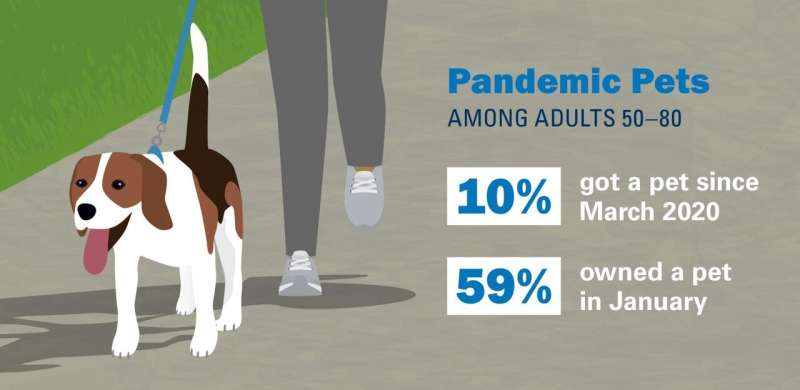
A lot of the attention around “pandemic pets” has focused on families with children getting a cat, dog or other pet in 2020, during a time when many people were learning or working from home.
But a new poll shows that older adults also got in on the trend.
According to the National Poll on Healthy Aging, 10% of all people between the ages of 50 and 80 got a new pet between March 2020 and January 2021.
The percentage was indeed higher—16%—among the people in this age range who have at least one child or teen living with them. But the vast majority of people between the ages of 50 and 80 don’t live with someone under age 18—and nearly 9% of them also got a pet during the pandemic.
All told, 59% of people age 50 to 80 who completed the poll in January 2021 are pet owners. Among those who said in January that they are pet owners, 17% had gotten at least one pet since the pandemic began. The poll did not ask if this was their first pet or an additional pet.
Pet ownership was higher among those age 50 to 64, women, white respondents and those who live in single-family detached homes or are employed. Twelve percent of older adults who are employed said they got a pet since March 2020.
The poll is based at the University of Michigan’s Institute for Healthcare Policy and Innovation and receives support from AARP and Michigan Medicine, U-M’s academic medical center.
The new data are an update to a previous report by the poll team, published in April 2019. That full report showed that older adults say having a pet helps them enjoy life, reduce stress, have a sense of purpose, and stick to a routine, as well as connect with other people and be physically active, especially for dog owners. Among those older adults who lived alone or were in fair or poor health when the 2019 poll was done, nearly three-quarters said the pet helped them cope with physical or emotional symptoms.
Of those who live alone, the percent having a pet jumped 12 points between the sample reported in 2019 and the January 2021 sample. The role of pets as companions for older adults living alone is an important one, especially during the pandemic when many older adults stayed home because of their higher risk of developing severe COVID-19 if they caught the coronavirus.
Poll director Preeti Malani, M.D., has first-hand experience with getting a “pandemic puppy” to join her family, which includes a high schooler studying at home. It’s the first time they’ve had any type of pet.
Malani notes that on the one hand, her family’s new dog has demanded more attention than they might have expected—especially given that she and her husband are busy physicians working both remotely and face to face with patients. But on the other hand, walking, playing and cuddling with the dog has been a welcome distraction during troubling times.
“Sully has been a great addition,” she says. “He makes sure we get outside every day. I’ve also met several other dog owners in the neighborhood.”
The animal shelter nearest the University of Michigan, the Humane Society of Huron Valley, has seen record-high adoption rates in the past year, says Wendy Welch, director of communications.
“We are delighted to see not just worthy animals get homes, but also to see people get much needed unconditional love as well,” she says. “While grandparents have sadly been separated from hugging their grandchildren, furry friends have been okay to snuggle. It’s well documented that pets can help lower our blood pressure, ease anxiety and improve symptoms of depression. And of particular interest during this isolating pandemic, companion animals certainly stave off the silent killer: loneliness. We are so thankful to the older adults who’ve opened up their hearts and homes to shelter animals during this time.”
Source: Read Full Article
